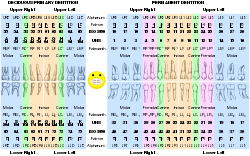FDI World Dental Federation notation
FDI World Dental Federation notation is a dental notation widely used by dentists internationally to associate information to a specific tooth.[1]
Developed by the FDI World Dental Federation, World Dental Federation notation is also known as ISO 3950[2] notation.
Orientation of the chart is traditionally "dentist's view", i.e. patient's right corresponds to notation chart left. The designations "left" and "right" on the chart below correspond to the patient's left and right.
Video of FDI Notation system
Table of codes

X-ray of the teeth and jaw showing the normal permanent teeth. The last two teeth on the patient's left (the dentist's right), 28 and 38 - the maxillary and mandibular third molars (popularly the upper and lower wisdom teeth) are severely impacted.
| Permanent teeth | |||||||||||||||
|---|---|---|---|---|---|---|---|---|---|---|---|---|---|---|---|
| patient's upper right | patient's upper left | ||||||||||||||
| 18 | 17 | 16 | 15 | 14 | 13 | 12 | 11 | 21 | 22 | 23 | 24 | 25 | 26 | 27 | 28 |
| 48 | 47 | 46 | 45 | 44 | 43 | 42 | 41 | 31 | 32 | 33 | 34 | 35 | 36 | 37 | 38 |
| patient's lower right | patient's lower left | ||||||||||||||
| Deciduous teeth (baby teeth) | |||||||||||||||
| upper right | upper left | ||||||||||||||
| 55 | 54 | 53 | 52 | 51 | 61 | 62 | 63 | 64 | 65 | ||||||
| 85 | 84 | 83 | 82 | 81 | 71 | 72 | 73 | 74 | 75 | ||||||
| lower right | lower left | ||||||||||||||

Comparison of alpha-numeric notation, Palmer notation method, ISO 3950 notation, Universal numbering system and paleoanthropology notation
Codes, names, and usual number of roots: (see chart of teeth at Universal Numbering System)
- 11 21 51 61 maxillary central incisor 1
- 41 31 81 71 mandibular central incisor 1
- 12 22 52 62 maxillary lateral incisor 1
- 42 32 82 72 mandibular lateral incisor 1
- 13 23 53 63 maxillary canine 1
- 43 33 83 73 mandibular canine 1
- 14 24 maxillary first premolar 2
- 44 34 mandibular first premolar 1
- 15 25 maxillary second premolar 1
- 45 35 mandibular second premolar 1
- 16 26 54 64 maxillary first molar 3
- 46 36 84 74 mandibular first molar 2
- 17 27 55 65 maxillary second molar 3
- 47 37 85 75 mandibular second molar 2
- 18 28 maxillary third molar 3
- 48 38 mandibular third molar 2
How the codes are constructed
Syntax: <quadrant code><tooth code>
Sometimes a dot is inserted between quadrant code and tooth code in order to avoid ambiguity with other numbering systems.
|
|
Examples:
- "13" = permanent upper right canine
- "32" = permanent lower left lateral incisor
gollark: Assuming the laws of multiplication and wild random guessing hold true, I can put up four and get a gold?
gollark: _ponders sticking up spare aethers now_
gollark: Madness.
gollark: Wait, what?
gollark: ```Rare: Impossible to get unless you're SunFish```
See also
- Dental notation
- Universal numbering system
- Palmer notation
References
- FDI Two-Digit Notation Archived 2007-04-01 at the Wayback Machine, hosted on the FDI World dental Federation website. Page accessed April 1, 2007.
- ISO 3950:2009 Dentistry — Designation system for teeth and areas of the oral cavity
External links
This article is issued from Wikipedia. The text is licensed under Creative Commons - Attribution - Sharealike. Additional terms may apply for the media files.